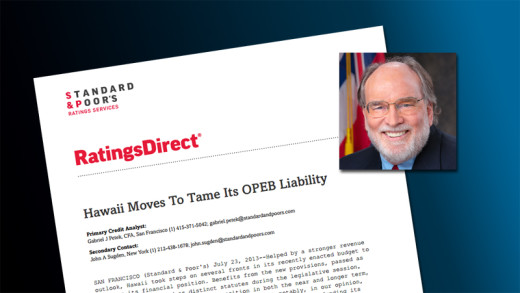 HONOLULU, Hawaii – Hawaii Governor Neil Abercrombie spoke with enthusiasm during last Friday’s “Cabinet in your Community” gathering at UH-Hilo. The topic was the state’s financial outlook, and the governor had good news for those in attendance.
HONOLULU, Hawaii – Hawaii Governor Neil Abercrombie spoke with enthusiasm during last Friday’s “Cabinet in your Community” gathering at UH-Hilo. The topic was the state’s financial outlook, and the governor had good news for those in attendance.
“Incoming taxes from corporations, the measure of how business is doing in the state of Hawaii… as of June 30 were up 38% percent,” said the governor. “I believe that we will be able to report that this cabinet will be operating on the basis of no less than $400 million… and I believe we have a shot at having as much as $500 million dollars positive balance the end of this fiscal year.”
More good news on Tuesday: Standard & Poor’s Ratings Services delivered a favorable assessment, acknowledging the State of Hawaii has strengthened its financial position. (The state provided copy of the media release, available below this article)
The Governor released this statement about the assessment:
 Gov. Neil Abercrombie Gov. Neil Abercrombie |
|
The Standard & Poor’s Ratings Services media release:
| SAN FRANCISCO (Standard & Poor’s) July 23, 2013–Helped by a stronger revenue outlook, Hawaii took steps on several fronts in its recently enacted budget to shore up its financial position. Benefits from the new provisions, passed as part of the budget and as distinct statutes during the legislative session, will strengthen the state’s fiscal position in both the near and longer term, in Standard & Poor’s Ratings Services’ view. Most notably, in our opinion, the state initiated a multiple year process of increasingly prefunding its other postemployment benefit (OPEB) liability in the form of its large retiree health care benefit. It also took advantage of an improving revenue picture to rebuild budget reserves, which it had been drawing down in recent years. And finally, with an eye to the state’s finances beyond the two-year budget window, the state made permanent some temporary tax revenue enhancements that were scheduled to sunset in fiscal 2015. Taken together, we view these actions as having favorable implications for the state’s credit profile.At the same time, however, we believe the budget also includes some new spending on program enhancements that could eventually result in fiscal pressure. In particular, general fund spending, budgeted to increase 10.9% in fiscal 2014 and a more modest 1.2% in fiscal 2015, is growing faster than the state’s 4.7% average total personal income growth since 2000. Some of the growth relates to the state’s new pre-kindergarten education program and some reinvestment in computer technology and accounting systems that may offer longer term efficiencies.
For the current biennium, the state’s economic climate and rising revenue trajectory help accommodate the efforts at both fiscal consolidation and program expansion. And, in our view, by rebuilding its “rainy day” reserves and beginning to confront long-term debt pressures while the economy isgrowing, the state is exhibiting the financial management characteristics consistent with its rating category. A key to the state’s future credit trajectory likely hinges on its ability to follow through on its OPEB funding measures when revenue growth ebbs lower. In our view, building up its budgetary reserves now helps enhance its future fiscal flexibility and better positions it to weather an economic slowdown should one occur. CONTRIBUTING THE ARC TO OPEB IS A MULTIPLE-YEAR PROJECT Because the new funding policy will take several years to ramp up, the full benefits may not be realized in the short term (one to two years). Moreover, assuming economic and tax revenue trends soften at some point in the next several years, we believe the state’s commitment to the new higher contributions could be put to the test. In general, we view the state’s willingness to begin confronting its OPEB liability as favorable. We have previously noted that, at $13.6 billion as of fiscal 2012 or $9,750 per capita (2012 population estimates), the state’s OPEB liability poses a risk to the state’s long-term credit quality. The new legislation, even if it does not result in immediate improvement to the state’s rating, is beneficial to our view of its credit quality. RECAPITALIZING RESERVES DEMONSTRATES COMMITMENT TO FISCAL SOUNDNESS BOOST TO REVENUE BASELINE BENEFITS STATE’S FISCAL STRUCTURE BEYOND THE CURRENT BIENNIUM Standard & Poor’s Ratings Services, part of McGraw Hill Financial (NYSE:MHFI), is the world’s leading provider of independent credit risk research and benchmarks. We publish more than a million credit ratings on debt issued by sovereign, municipal, corporate and financial sector entities. With over 1,400 credit analysts in 23 countries, and more than 150 years’ experience of assessing credit risk, we offer a unique combination of global coverage and local insight. Our research and opinions about relative credit risk provide market participants with information and independent benchmarks that help to support the growth of transparent, liquid debt markets worldwide. |

by Big Island Video News9:31 am
on at
STORY SUMMARY
HONOLULU, Hawaii – Hawaii Governor Neil Abercrombie spoke with enthusiasm during last Friday’s “Cabinet in your Community” gathering at UH-Hilo. The topic was the state’s financial outlook, and the governor had good news for those in attendance. “Incoming taxes from corporations, the measure of how business is doing in the state of Hawaii… as of […]